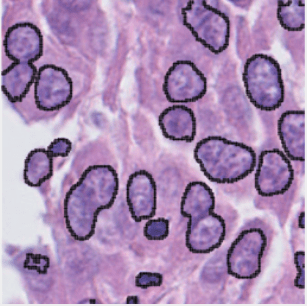Invited Talk: Prof. Dr. Thomas Walter, École des Mines de Paris – Computer vision for histopathology and spatial transcriptomics, Thu, Jan 23rd, 2025, 11 AM CET
It’s a great pleasure to welcome Prof. Dr. Thomas Walter, Director of the Center for Computational Biology, École des Mines de Paris to our lab!
Title “Computer vision for histopathology and spatial transcriptomics”.
The talk will be this Thursday, Jan 23, 2025, at 11:00 in room 02.134-113 in Martensstraße 3 (2nd floor of the blue CS tower).
Abstract:
Whole slide images (WSI) are microscopy images of stained tissue sections, routinely used in cancer treatment centers for diagnosis, patient stratification, and treatment selection. WSIs are large and complex, often containing hundreds of thousands of individual cells, and their analysis requires specialized algorithmic solutions.
Spatial Transcriptomics (ST) is a technique that maps gene expression to specific locations within a tissue, thus combining spatial information with transcriptomic data. ST allows the study of spatial organization of cellular processes and how they relate to tissue structure and function. ST comes with many computational challenges, such as single-cell deconvolution, multi-modality predictions and image segmentation.
In this lecture, I will present our recent developments in these fields. First, I will discuss our recently published approach for predicting Homologous Recombination Deficiency (HRD), a defect in the DNA repair pathway that makes cancer cells more sensitive to treatment with PARP inhibitors. Next, I will introduce our slide-level foundation model, Giga-SSL, which provides slide-level encodings for the entire TCGA dataset, enabling the training of predictive models without requiring specialized hardware or deep learning expertise. Finally, I will share unpublished work on cell segmentation in ST data and models to predict single-cell gene expression from WSIs, leveraging paired H&E and spatial transcriptomics data.
Prof. Dr. Thomas Walter:
Thomas Walter received his engineering degree from Saarland University in 1999 and completed his PhD thesis at the Centre for Mathematical Morphology at Mines Paris in the field of Computer Aided Diagnosis of Diabetic Retinopathy, a severe and frequent eye disease. He then joined the Ellenberg lab at the European Molecular Biology Laboratory (EMBL) in Heidelberg, where he developed Computer Vision methods to analyse the first genome-wide RNAi screen by live cell imaging in a human cell line in order to identify genes required for cell division. In 2012, he joined the Centre for Computational Biology at Mines Paris, first as an independent researcher and since 2018 as director. His work focuses on Bioimage Informatics with applications to High Content Screening and Computational Pathology. Since 2019, he holds a chair at the PaRis Artificial Intelligence Research InstitutE (PRAIRIE), and he is a full professor of Mines Paris since 2021.
